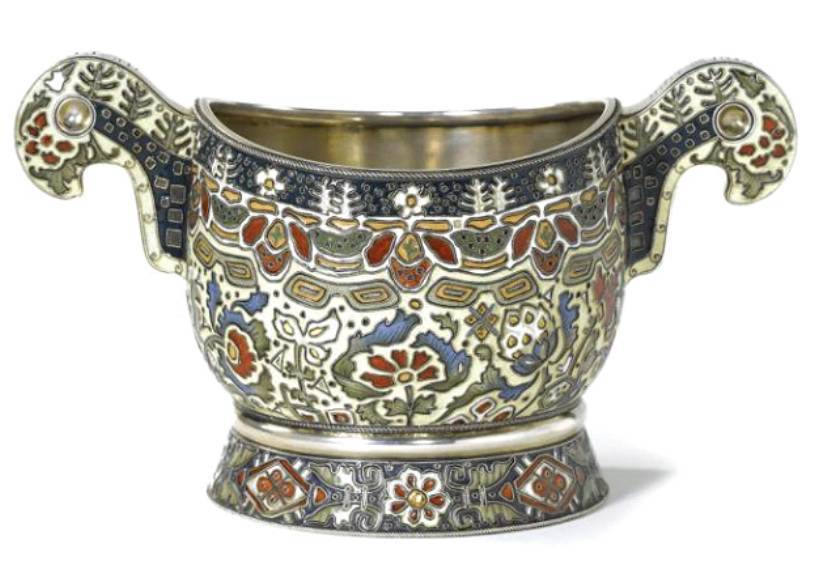Работы Рюккерта, проданные на аукционе Сотбис
Russian Works of Art, Faberge and Icons
Sale: L08118
Location: London, New Bond Street
Auction Dates: November 26, 2008
Session :
Sale: L08118
Location: London, New Bond Street
Auction Dates: November 26, 2008
Session :
LOT 207
PROPERTY FROM A PRIVATE COLLECTION, NETHERLANDS
A FABERGE SILVER-GILT AND CLOISONNE ENAMEL BRATINA, WORKMASTER: FEDOR RUCKERT, MOSCOW, 1899-1908
A FABERGE SILVER-GILT AND CLOISONNE ENAMEL BRATINA, WORKMASTER: FEDOR RUCKERT, MOSCOW, 1899-1908
60,000 - 80,000 GBP
MEASUREMENTS
height: 14cm., 5 1/2 in.
DESCRIPTION
the bulbous bowl finely enamelled with stylised flowers and geometric ornament in muted tones, flanked by similarly decorated scroll handles, inscribed in Latin J.J.v.d.P. and dated 28/VII/1887-1912, marked K.Faberge beneath the Imperial Warrant, with workmaster's initials and scratched inventory number 14316, 91 standard
CATALOGUE NOTE
height: 14cm., 5 1/2 in.
DESCRIPTION
the bulbous bowl finely enamelled with stylised flowers and geometric ornament in muted tones, flanked by similarly decorated scroll handles, inscribed in Latin J.J.v.d.P. and dated 28/VII/1887-1912, marked K.Faberge beneath the Imperial Warrant, with workmaster's initials and scratched inventory number 14316, 91 standard
CATALOGUE NOTE
Feodor Ivanovich Ruckert was born Friedrich Mauritz Ruckert in Alsace-Lorraine in 1840, emigrating to Russia at the age of fourteen to work for either the Youssupov or Golitsyn family. For thirty years, from 1887, the year in which the Moscow branch of Faberge opened, until the Revolution in 1917, the year of his death, Ruckert was the only workmaster for cloisonnй enamel in the Faberge firm. He produced highly original works of exceptional quality in evolving styles for Faberge, while also supplying other retailers including Kurlyukov and selling much of his production direct to the consumer.
Although of Western background, Ruckert found no difficulty in employing traditional Russian forms - in particular the kovsh - and decorative motifs in his work. By the turn of the century, the Old Russian stylistic elements of his objects were mixed with refreshing Art Nouveau devices, a natural combination as both styles were based on arabesque and foliate forms. This later work, including the present lot, was almost certainly influenced by his son Pavel, who finished his studies at the famous Strogonov School of Technical Drawing sometime between 1906 and 1908 and then returned to work in his father's workshop, bringing new ideas and thus new motifs to the master's work.
Sylistically, the present lot compares with the bratina, formerly in the collection of the Countess of Torby (1868-1927), morganatic wife of Grand Duke Michael Mikhailovich, illustrated G. von Habsburg, Faberge Hofjuwelier de Zaren, Munich, 1986, no. 83, p. 134, which exhibits similar motifs and palette.
Although of Western background, Ruckert found no difficulty in employing traditional Russian forms - in particular the kovsh - and decorative motifs in his work. By the turn of the century, the Old Russian stylistic elements of his objects were mixed with refreshing Art Nouveau devices, a natural combination as both styles were based on arabesque and foliate forms. This later work, including the present lot, was almost certainly influenced by his son Pavel, who finished his studies at the famous Strogonov School of Technical Drawing sometime between 1906 and 1908 and then returned to work in his father's workshop, bringing new ideas and thus new motifs to the master's work.
Sylistically, the present lot compares with the bratina, formerly in the collection of the Countess of Torby (1868-1927), morganatic wife of Grand Duke Michael Mikhailovich, illustrated G. von Habsburg, Faberge Hofjuwelier de Zaren, Munich, 1986, no. 83, p. 134, which exhibits similar motifs and palette.
